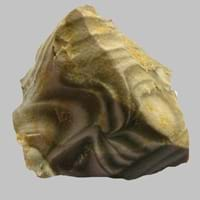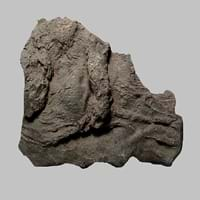Definition
Flint is a hard type of sedimentary rock that produces a small piece of burning material when hit by steel
During the impact melted material forming a breccia containing glass and crystal or lithic fragments together form Suevite rock.
Origin
Unknown
Canada, Germany
Discoverer
Unknown
Unknown
Etymology
From Old English flint - a type of rock mainly known for high hardness and for giving off sparks when struck
No etymologies found
Class
Sedimentary Rocks
Metamorphic Rocks
Sub-Class
Durable Rock, Hard Rock
Durable Rock, Medium Hardness Rock
Group
Not Applicable
Not Applicable
Other Categories
Fine Grained Rock, Opaque Rock
Coarse Grained Rock, Opaque Rock
Texture
Banded, Rough
Earthy
Color
Black, Brown, Green, Grey, Red, White
Black, Brown, Colourless, Green, Grey, Pink
Durability
Durable
Durable
Scratch Resistant
Yes
Yes
Appearance
Glassy or Pearly
Banded
Interior Uses
Decorative Aggregates, Homes, Interior Decoration
Decorative Aggregates, Homes, Interior Decoration
Exterior Uses
As Building Stone, As Facing Stone, Garden Decoration, Office Buildings, Paving Stone
As Building Stone, As Facing Stone, Garden Decoration, Office Buildings
Other Architectural Uses
Curbing
Curbing
Construction Industry
Arrowheads, Cutting Tool, Spear Points
As Dimension Stone, Cement Manufacture, for Road Aggregate, Making natural cement, Manufacture of Magnesium and Dolomite Refractories
Medical Industry
Not Yet Used
Not Applicable
Antiquity Uses
Artifacts
Artifacts, Monuments, Sculpture
Commercial Uses
Creating Artwork, Gemstone, In fire-starting tools, Manufacture of tools, Metallurgical Flux, Jewelry, To ignite fire, Used in flintlock firearms
As a Feed Additive for Livestock, Gemstone, Metallurgical Flux, Source of Magnesia (MgO)
Types
Not Available
Phyllosilicates, Calcite
Features
Clasts are smooth to touch, Easily splits into thin plates, Has High structural resistance against erosion and climate
Host Rock for Lead
Archaeological Significance
Monuments
Not Yet Used
Used
Famous Monuments
Not Applicable
Data Not Available
Sculpture
Not Yet Used
Used
Famous Sculptures
Not Applicable
Data Not Available
Pictographs
Not Used
Used
Petroglyphs
Not Used
Used
Figurines
Not Yet Used
Used
Formation
Flint is formed by the decomposition and compaction of various organisms such as sponges and diatoms under the water.
Suevite is a metamorphic rock consisting partly of melted material, typically forming a breccia containing glass and crystal or lithic fragments, formed during an impact event.
Mineral Content
Silicon
Coesite, Quartz, Stishovite
Compound Content
Silicon Dioxide
CaO, Carbon Dioxide, MgO
Types of Metamorphism
Not Applicable
Burial Metamorphism, Cataclastic Metamorphism, Contact Metamorphism, Hydrothermal Metamorphism, Impact Metamorphism, Regional Metamorphism
Types of Weathering
Not Applicable
Not Applicable
Types of Erosion
Chemical Erosion, Coastal Erosion, Water Erosion
Not Applicable
Grain Size
Very fine-grained
Coarse Grained
Fracture
Conchoidal
Uneven
Streak
White
Light to dark brown
Porosity
Highly Porous
Less Porous
Compressive Strength
Not Available
Cleavage
Non-Existent
Irregular
Toughness
1.5
Not Available
Specific Gravity
2.5-2.8
2.86
Transparency
Translucent to Opaque
Opaque
Density
2.7-2.71 g/cm3
2.8-2.9 g/cm3
Resistance
Heat Resistant, Impact Resistant, Pressure Resistant, Wear Resistant
Heat Resistant
Deposits in Eastern Continents
Asia
Azerbaijan, China, Russia
Not Yet Found
Africa
Not Yet Found
Not Yet Found
Europe
Austria, Belgium, Cyprus, Denmark, France, Germany, Italy, Malta, Netherlands, Poland, Portugal, Romania, Spain, Sweden, Switzerland, Turkey, Ukraine, United Kingdom
England, France, Germany, Great Britain, Netherlands, Sweden, Switzerland, United Kingdom
Others
Not Yet Found
Not Yet Found
Deposits in Western Continents
North America
USA
Not Yet Found
South America
Bolivia
Not Yet Found
Deposits in Oceania Continent
Australia
New Zealand, South Australia
Not Yet Found
All about Flint and Suevite Properties
Know all about Flint and Suevite properties here. All properties of rocks are important as they define the type of rock and its application. Flint belongs to Sedimentary Rocks while Suevite belongs to Metamorphic Rocks.Texture of Flint is Banded, Rough whereas that of Suevite is Earthy. Flint appears Glassy or Pearly and Suevite appears Banded. The luster of Flint is vitreous while that of Suevite is earthy. Flint is available in black, brown, green, grey, red, white colors whereas Suevite is available in black, brown, colourless, green, grey, pink colors. The commercial uses of Flint are creating artwork, gemstone, in fire-starting tools, manufacture of tools, metallurgical flux, jewelry, to ignite fire, used in flintlock firearms and that of Suevite are as a feed additive for livestock, gemstone, metallurgical flux, source of magnesia (mgo).










